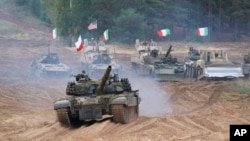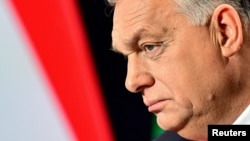
Welcome to Wider Europe, RFE/RL's newsletter focusing on the key issues concerning the European Union, NATO, and other institutions and their relationships with the Western Balkans and Europe's Eastern neighborhoods.
I'm RFE/RL Europe Editor Rikard Jozwiak, and this week I'm drilling down on two issues: NATO's biggest exercise in decades; and more EU sanctions on Russia.
Brief #1: NATO's 'Biggest Exercise Since The Cold War'
What You Need To Know: In late January, NATO began what it has called its “largest military exercise since the Cold War.”
Steadfast Defender 24 involves 90,000 troops from all 31 alliance members as well as NATO invitee Sweden for four months of maneuvers by land, sea, and air.
You have to go all the way back to 1988 for the last NATO exercise that involved more troops: Reforger with 125,000. In between, the Trident Juncture exercise in 2018 included 50,000 personnel.
While official NATO documents don’t say outright that they’re training against a potential Russian offensive on allied territory, it’s clear that’s what is on their minds.
The alliance says it is testing responses “during a simulated emerging conflict scenario with a near-peer adversary.”
Exercise maps will show an adversary with a fictitious name, but privately my NATO sources acknowledge without hesitation that “of course this means Russia.”
Deep Background: Take a look at the geography and what the alliance will practice, and it becomes even more evident.
Roughly speaking, Steadfast Defender 24 includes two phases. The first, which kicked off slowly at the end of January, involves the transatlantic reinforcement of forces. This is in fact the key to see if the United States can effectively deploy a large number of troops and equipment to continental Europe to mount a defense.
Don’t underestimate the symbolism, as the United States nears a presidential election that culminates on November 5. The image of U.S. troops training alongside other nations in mock amphibious assaults in the Atlantic in the next two months, involving more than 50 naval vessels including aircraft carriers, frigates, and destroyers, could help assuage European fears of a less committed United States down the road.
The second phase of the exercise is equally crucial and is likely to show whether NATO is capable of defending its vulnerable eastern flank -- “every inch of allied territory,” as NATO officials like to put it.
Starting in mid-February and running till the end of May, many of the elements will take place on land and in the sky, involving up to 80 air platforms including F-35 fighter jets, helicopters, and drones, as well as more than 1,000 combat vehicles, including 166 tanks.
The epicenter is Poland, where a major river crossing will be attempted in March, but also in the Baltic states, with Germany acting as a major hub for reinforcement and coordination.
There will also be exercises throughout the Nordic region, as well as the Czech Republic, Hungary, North Macedonia, and Romania.
Drilling Down
- This will also represent the first proper chance for NATO to test aspects of its new defense plans agreed at the Vilnius NATO summit in July, a 4,000-page document in which every ally should know exactly which part of alliance territory it should defend if NATO is attacked.
- Another big test is seeing how well the alliance’s Very High Readiness Joint Task Force (VJTF), which was created as a direct response to Russia’s annexation of Crimea in 2014, functions. It will be one of the bloc’s key components to defend any potential attack, with some 6,000 troops that should be deployable within days to any corner of the alliance.
- One of the aims of Steadfast Defender is ensuring this reaction force can be deployed together with various national forces once each year, starting from 2025. So this year is very much a test run.
- While the exercise has been planned for years, it comes at a pivotal time. Two years into Russia’s full-scale invasion of Ukraine, it should act as assurance that the alliance is ready in case the war creeps closer or even spreads across NATO members’ borders.
- While no Ukrainian troops are participating, the specter of the war in that country looms large in planners’ minds. Speaking to media in early February, NATO Brigadier General Gunnar Bruegner said “there is this unified sense that we need to go bigger, we need to train harder” when asked about the impact of the war on the alliance.
- The real question, however, is whether it will truly allay fears in Europe. Firstly, weapons deliveries to Ukraine have dropped alarmingly in recent months. The chairman of NATO’s military committee, Rob Bauer, said last fall that Western arms industries need to ramp up, as "the bottom of the barrel is now visible.”
- Then there have been plenty of recent official warnings that European allies must step up and prepare for the war potentially escaping containment to spread beyond Ukraine. And it’s not just Ukraine’s neighbors.
- The Belgian Army chief Michel Hofman suggested that Putin opening a second front in Moldova or the Baltics is not out of the question. And Hofman’s Swedish counterpart, Micael Byden, warned in late January that his countrymen “mentally must prepare for war,” triggering a slight panic as the public rushed out to buy extra fuel and survival kits.
Brief #2: The Puny New EU Sanctions Package Targeting Russia
What You Need To Know: The EU is aiming to adopt another sanctions package to deal a blow to Russia coincident with the second anniversary of the launch of the Ukrainian invasion on February 24, 2022.
The package would be the 13th imposed on Moscow since then. But early indications from EU diplomats speaking on condition of anonymity are that this round will be the weakest of the lot. It will mostly entail listings, meaning names of individuals and companies whose assets will be frozen inside the bloc and who will be slapped with visa bans -- not sector-wide sanctions targeting the Russian economy.
Nearly 2,000 people and companies have been blacklisted by the club so far, including Russian President Vladimir Putin and many in his inner circle. However, the sectoral sanctions tend to be more hard-hitting. They have so far targeted Russian coal, steel, wood, and oil exports into the union or the flow of EU goods to Russia including, for example, semiconductors and luxury goods.
Deep Background: The listings consist of up to 250 individuals or companies being presented by the European Commission, the EU’s executive arm, to EU member states in two batches. One came last week and includes 118 names; the other is expected this week.
The reason for the division is that the European External Action Service, the EU’s diplomatic corps, still needs time to go through the evidence packages with an eye to why the proposed targets should be listed. These evidence packages are frequently prepared by individual EU member states’ foreign ministries, often with help from their embassies in Moscow and/or Kyiv.
For this round, as I understand it, eight or so member states sent listing proposals to Brussels. In the first batch, seen by RFE/RL, most of the names come from the military sector, including companies that are producing ammunition and drones for Russia’s army; there are also individuals active in politics on behalf of Moscow in Ukrainian territories currently occupied by Russia.
The second batch will reportedly include Belarusian officials, judges, and media personalities whom Brussels deems to be “propagandists” supporting Russia’s war efforts.
There is still another type of sanction that the European Commission might propose: adding companies to “Annex Four.”
This is a list of over 600 companies, mainly Russian, with whom EU firms are banned from trading with because Brussels suspects them of contributing to Russia's war machine, largely via so-called dual-use items that might otherwise be found among standard household appliances -- let’s say computer chips for washing machines -- but are instead acquired for use in military equipment like drones.
The proposal is for the inclusion of around 25 new companies, the majority from Russia. But as I understand it, some might be from China, India, Turkey, Serbia, and Kazakhstan.
The question is whether they all remain on the list once ambassadors from the 27 member states debate the package.
Beijing has previously lobbied successfully to remove proposed listings under Annex Four, and it is likely to try again. Turkey and Serbia, who enjoy close political and economic ties with many EU member states, may also attempt to get companies from their national jurisdiction delisted.
Drilling Down
- The point for broader discussion, though, is why the European Commission opted mainly for listings. I understand from diplomats familiar with the file that the commission wanted something that could be agreed quickly in time for the February anniversary.
- The truth is that agreement on the EU sanctions packages has become more complicated, particularly in the last few rounds as member states have spent weeks or even months hashing out details such as economic sanctions.
- To adopt only listings of individuals makes sense, then, as it should only take EU member states a few meetings to sign off on them ahead of February 24. commission officials I’ve spoken with off the record have also pointed out that the package was coordinated with the Group of Seven leading industrial nations and that there was agreement that listings are easier to green-light.
- Still, I understand that some EU member states are unhappy and underwhelmed with the package. The critics point out that something hard-hitting against Moscow would be more apt in marking such a significant date, especially as Russia continues its missile barrages against Ukrainian cities.
- Some member states -- notably Estonia, Latvia, Lithuania, and Poland -- sent a discussion paper seen by RFE/RL to the commission in January with proposed items to sanction including in the Russian nuclear sector, liquefied natural gas (LNG), aluminum in addition to a prohibition on EU companies providing any IT or cloud services to Russia.
- None of the proposals appears to have been taken on board. Neither has a Czech idea to ban the movement inside the bloc of Russian diplomats still posted to EU countries. Prague’s proposal was deemed impractical by EU officials, as travel inside the passport-free Schengen zone is difficult to control.
- In a letter seen by RFE/RL and addressed to European Commission President Ursula von der Leyen and signed by the foreign ministers of the Baltic states plus Denmark, Finland, and Sweden, there is a request for the commission “to present a proposal of sectoral sanctions as soon as possible.” The signatories add that “our focus should be on further cutting Russian revenues to finance the war, cutting its access to sensitive goods and technology empowering its military machine.”
- My understanding is that the commission has promised member states to return to the issue of sectoral sanctions directly after passage of the 13th package is ensured. There is, however, a risk that new measures will be harder to accept as June’s European Parliament elections grow nearer and that efforts will instead focus on the autumn.
Looking Ahead
NATO defense ministers convene in Brussels for their first official meeting of the year on February 15. They will examine issues including a review of the alliance’s air- and missile-defense posture on its eastern flank, defense spending among the 31 members, and how to encourage more joint procurement of ammunition and arms.
Keep an eye out for the Munich Security Conference on February 16-18. It’s widely regarded as the most important annual security forum, bringing together decision-makers from around the globe. Expect plenty of debate on the war in Ukraine, with President Volodymyr Zelenskiy among this year’s scheduled speakers. Read my takeaways from Bavaria in the next edition of this newsletter.
That's all for this week. Feel free to reach out to me on any of these issues on Twitter @RikardJozwiak, or by e-mail at jozwiakr@rferl.org.
Until next time,
Rikard Jozwiak
If you enjoyed this briefing and don't want to miss the next edition, subscribe here.





